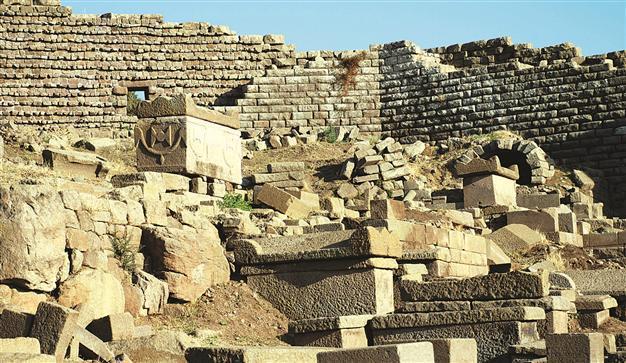‘Meat eater’ tombs in Assos display the taste for flesh
ÇANAKKALE – Anadolu Agency

The word 'tomb' first appeared in Assos and was used as a concept to explain the stones in the city. AA Photo
Forget about lions, tigers or other big predators, the real carnivores in Assos in Çanakkale are the ancient city’s tombs, whose stones are famous for causing bodies to decompose in record time.“The tombs here are first cut roughly, and their interior is carved. We know that the decorations on the tombs were made in the graveyard. Some long-time researchers have been trying to find out if the bodies decomposed in the tombs because of the stone used. Some researchers claim that the tombs include lots of aluminum material, and that that causes decomposition. Maybe the locals of Assos found that aluminum burned the skin and put this material inside the tombs for the body to decompose within a short time. In this way, the tombs of Assos have become famous around the world,” said Çanakkale 18 Mart University (ÇOMÜ) Archaeology Department Professor Nurettin Aslan, who is the head of the excavations in the ancient city.
Aslan said the word “tomb” first appeared in Assos and was used as a concept to explain the stones in the city.
The professor also said the Roman writer Plinius, in his a 37-volume work titled “History of Nature,” talked about the type of stone used in the Assos tombs.
“He says the bodies that are put inside the tombs, which are made of this stone, completely decompose in 40 days. We know that other ancient resources mention the fame of this type of stone. Thanks to these resources, we found out that magnificent tombs were made of this stone,” he said.
Arslan also said the empty tombs were sent to other countries. “The fact that these tombs are in different countries show that they were very expensive tombs. We can say that the Assos tombs were particularly preferred by people who read Plinius. The tombs are generally two meters long and 80-to-90 centimeters wide. It is possible to see wider and longer tombs in Assos, too. Their weight is about three tons. The most important feature of tombs is that their material is andesite stone and they are decorated. They are unique to Assos only. For example, all tombs in Rome have three wreathes in their long side. It is two in the ones made in Assos.”
Examples of the special tombs still exist in stone pits on the north side of Assos, the professor said.
















